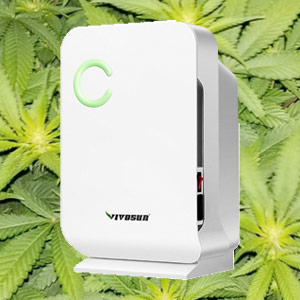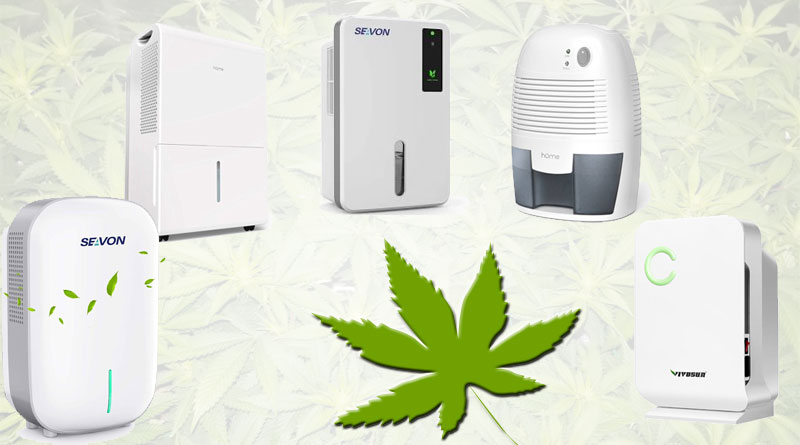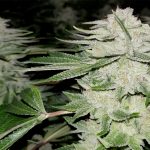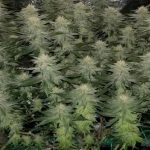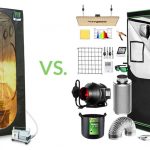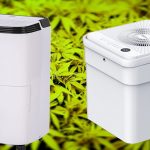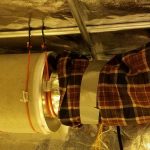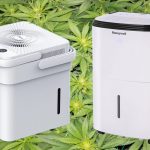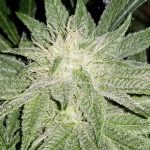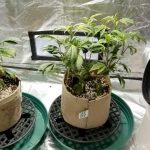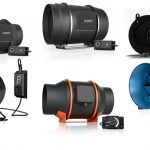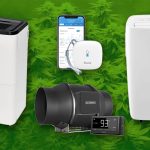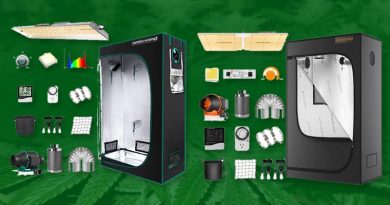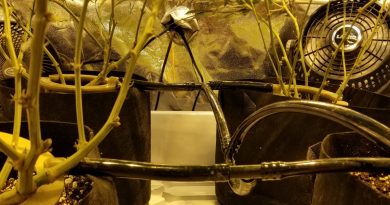Grow tent dehumidifier guide: best dehumidifier for grow tent use
Want to find the best dehumidifier for grow tent humidity issues?
We’ve been fixing grow tent humidity issues for a long time. We’ll show you how to lower humidity in a tent, what size grow tent dehumidifier to buy, what features and options you should consider, and where to place dehumidifiers for best results.
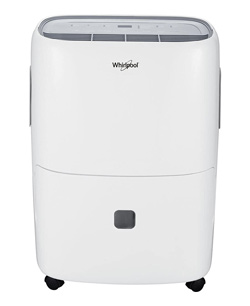
Your goal is to create an environment for your cannabis plants that falls within the optimal humidity levels:
- Vegetative stage: 40%-60%
- Flowering stage: 40%-50%
- Last few weeks of flowering stage: 40% or less
How to remove humidity from grow tents
Before you buy a grow tent dehumidifier there’s a few other things you should try first to remove humidity from your grow tent. Learn more about how to lower humidity in a grow tent here.
Increase your tent’s exhaust fan (and add a filtered intake fan if you don’t have one) to more quickly remove moist air. Use a humidity fan controller to turn the exhaust fan on as needed to keep things within suitable range.
For small and midsize (3×3, 4×4, 5×5, etc.) areas this usually will be adequate to lower humidity in a grow tent or grow room. Learn more about grow tent ventilation setup and how to find the best fan for a grow tent.
If you have adequate ventilation rates but the room air outside the tent is moister than your target humidity level then you’ll need to get a dehumidifier.
How big of a dehumidifier do I need for a grow tent?
The proper size dehumidifier for grow tent or grow room usage depends on your grow space’s volume and the severity of your humidity issues. Humidity levels tend to rise a lot as plants transpire moisture. More plants produce more moisture to remove.

A small dehumidifier under $100 might seem like the right size for a small tent. But those small units are not designed to remove a large volume of moisture. A small dehumidifier for grow tent or grow room use will struggle to keep up with moisture levels, and their tiny tanks will fill quickly. More powerful models are required.
Dehumidifiers are rated based on the number of pints of liquid per day that can be removed from the air. Dehumidifiers used to come rated as 30 pint, 50 point, and 70 pint-per-day models. But rating standards changed in 2019 when they started testing at lower temperatures, so now those identical units are rated as 20 pint, 30 pint, and 50 pint.
The amount you water your plants each day is roughly the amount of water you’ll introduce into the air. To be safe it’s better to get one that is more powerful than you think you’ll need.
So if you water 2.5 gallons (20 pints) per day in a relatively dry room, you’ll need to size up a bit and go with a 30 pint dehumidifier to be safe. If you water that same amount in a large already-damp basement, you’ll want to get a 50 pint model. For larger grows, consider a commercial 113 pint model.
If you need to dehumidify a large, damp space outside of your grow tent, you can get away with a full-size model. In moist basements during the summertime many homes need to run them full-time.
If your tent is located in similar damp basement conditions, you’ll need a model capable of keeping your basement within check. Otherwise the fresh air you introduce will already be too moist, and when coupled with the moisture introduced by your plants it will become a risk.
Grow shops near me feature an array of large commercial-sized units, but they don’t carry mid-size dehumidifiers for grow tents. Typically your best bet to find one is at box stores or on Amazon.
When should I run my dehumidifier in my grow tent?
Your dehumidifier should be set up to run using a humidity controller to keep you within the proper range.
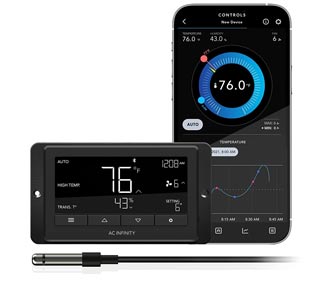
Most models come with a built-in controls to set the target humidity level. Smaller models that lack this feature can be turned on using a digital controller, such as the InkBird Humidity Controller. We use one to optimize humidity levels and it has worked great for years. Another good option is the bluetooth-enabled AC Infinity humidity and temperature controller.
You’ll find that humidity levels tend to vary when the lights are on vs. off, and as plants get bigger and bushier they tend to transpire more moisture. Using an automated humidity control takes the guesswork out of it. Plus they can be programmed to run for a specific range, so they don’t quickly cycle on and off repeatedly.
Keep in mind that if your bucket fills with water the unit will shut off. So empty it often or humidity will climb unexpectedly. And make sure to clean the filter often to keep airflow moving.
Where to place dehumidifier inside a grow tent

Dehumidifiers can be placed directly on the grow tent floor, out of the way of potential issues with spilled water. Position it so the unit’s fan circulates the dried air, but don’t point it directly at the plants if you can avoid it.
Grow tent dehumidifiers can also be propped up on an overturned 5 gallon bucket or small plastic shelf if you need to raise the height to facilitate water drainage through a hose.
Your tent should intake fresh air from the bottom and exhaust warmer, humid air at the top. Placing the dehumidifier low has the most impact, since as the tent air warms from the light it rises and gets sucked out of the exhaust duct. Placing a dehumidifier at the top of the tent means the device’s freshly dried air is quickly removed, reducing efficiency of the solution.
For small grow tents you can also place the dehumidifier outside of the tent near the intake fan. This introduces dry air while saving precious space inside the tent.
Choosing the best dehumidifier for a grow tent
When choosing a dehumidifier for your grow tent, there’s a few things to keep in mind.
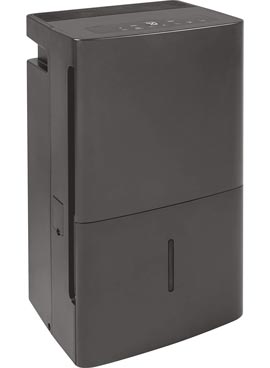
A small dehumidifier will have a small bucket, so you may find yourself having to change them often or risk having the dehumidifiers shut off when full. Emptying buckets sucks. Look for models that allow you to attach drainage holes to a nearby drain to minimize the hassle.
If you don’t have a low drain nearby look for a dehumidifier with a pump so you can pump out that water to a larger container outside of the tent. This ensures it won’t ever shut down due to a full bucket.
Built-in humidity controls are included on all but the smallest dehumidifier models. You can always use a separate humidity controller if you get a mini dehumidifier for grow tent usage.
One of the best dehumidifier options for grow tents is to get a model that is bluetooth connected and can be monitored on a phone app. This provides peace of mind so you know things are working as they should.
Word of warning: If you place your unit inside your grow area, make sure to cover all your dehumidifier’s lights with thick black duct tape like Gorilla Tape. You don’t want any light to seep out and interfere with your flowering cycle.
Find a dehumidifier for 4×4 grow tent
There’s not a lot of canopy square footage in a 4×4 grow tent, so the best dehumidifier for running inside grow tents would be small enough to sit under the canopy to avoid reducing the space plants receive light.
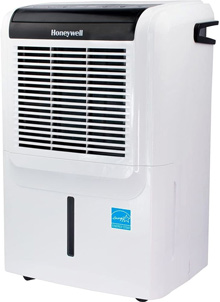
Place on the floor or on a small bucket if you need to raise it to angle a drain hose. If you’re using a larger dehumidifier in your 4×4 grow tent you may need to elevate your plants so the canopy is above it. Assuming you have enough vertical space you could put your plants on upside-down 5 gallon buckets to raise them.
Usually exhaust fans can prevent the need to buy a dehumidifier for 4×4 grow tent setups. Assuming your tent is 7 feet high, 4 x 4 x 7 = 112 cubic feet of air. Not a lot for even a small 4″ inline fan to remove. If you’re having issues with exhaust rate, reduce bends in ductwork and increase air intake volume (using a filtered intake fan or a DIY light-proof baffle against tent ventilation screens). Learn more about grow tent ventilation setup.
If you don’t want to sacrifice room inside of your 4×4 grow tent, a dehumidifier can be placed outside with it’s airflow pointed at your tent intake fan or vent. The air coming out of the unit will be very dry, so placing this air stream closer or further from the intake fan can further lower or raise the humidity of air being pulled in the tent.
Learn more about finding the best dehumidifier for 4×4 grow tent setups.
Best dehumidifier for 5×5 grow tent
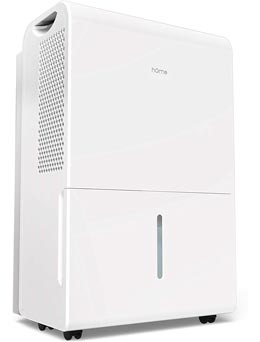
The best dehumidifier for a 5×5 grow tent (or a or a tent with similar volume) would be a 50 pint model such as the hOmeLabs 4,500 sq. ft dehumidifier.
If you’re planning to use the dehumidifier’s storage to collect water look for models with larger capacity. If you’re planning to run a drain tube look for models where you can easily attach a hose.
Look for a unit with a built-in pump so you can eject the water to a nearby sink or drain. This helps you avoid emptying buckets of water each day.
Similar to the 4×4 tent, a dehumidifier for 5×5 tent grows can also be placed outside of the tent to avoid wasting precious space where flowering buds could go.
Best dehumidifier for a 4×8 grow tent
Larger grow tents have more air volume and more humidity released from transpiring weed plants. The minimum dehumidifier needed for 4×8 grow tent setups would be a larger-sized 50 pint model if you’re watering about 5 gallons per day in a relatively dry environment.
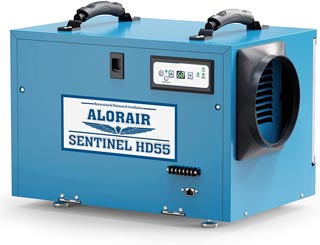
For larger grows in damp locations such as basements, consider a commercial 113 pint model.
Place the unit right inside your tent, so that the dry air isn’t being pushed right into any one plant. Use lots of circulation fans to keep air moving briskly inside the tent to keep everything as homogenous as possible. This is the type of setup you’ll need if you’re running a sealed 4×8 grow tent and supplementing carbon dioxide.
If you’re having humidity issues in a 4×8 grow tent you should look into a good humidity and temperature controller which can help you lock down ideal humidity ranges, turning on a humidifier, dehumidifier, or air conditioner as needed. In tents this size the humidity levels can vary quite a bit naturally when the lights are on vs. off as plants transpire. But if you’ve moved up to a 4×8 tent then you are more advanced than a smaller tent grower and likely want to dial in the environment as best you can.
Best dehumidifier for 3×3 grow tent
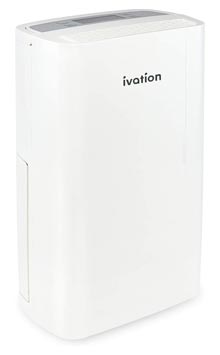
Most of the time you won’t need to buy a dehumidifier for a 3×3 grow tent or similarly sized grow space (2×4, 32″ x 32″, 2×2, etc.). Proper air ventilation should be sufficient to offset the transpiration rates of a few small weed plants.
The air volume of these tents is small and can quickly be changed over every minute using an exhaust fan running on a low setting. Plus there’s not a lot of space to put one, so you’d need to get a mini dehumidifier for grow tent sizes this small. Usually you should be more concerned with improving air intake rates. Use a small intake fan if needed.
If your tent’s enclosing room humidity is too high you can address that with a small dehumidifier. Set it so that room stays at 40-45%, so that the room air pulled into your tent’s intake vent will be slightly dryer then the target tent humidity based on the growth stage you’re in. Decrease target humidity if needed to fine-tune it.
If you do want to locate the unit inside your tent, get a mini dehumidifier with as much water storage as possible to keep it from shutting down when full. And don’t say you weren’t warned.
Choosing a mini dehumidifier for grow tents
Using a mini dehumidifier is helpful for small tents because they don’t take up much space. But they have a few drawbacks to consider. Many smaller models don’t move a lot of air, so they may have trouble keeping up with the constant transpiration that you’re looking to eliminate.
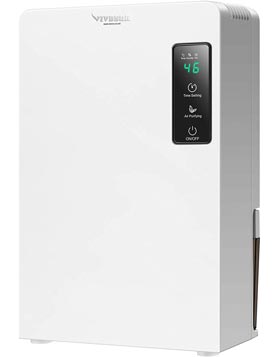
Water containers are small, so you’ll need to empty frequently. They often don’t have programmable controls, so they’ll just turn on when a certain predetermined threshold is reached (such as 40%). Many mini dehumidifier models also don’t have drain hoses, not ideal for lower-maintenance usage in grow tents.
Benefits of using a mini dehumidifier for grow tents are low prices and small size. But keep in mind that since your tent exhaust is ideally turning over the tent air every minute, using these inside the tent isn’t always the most efficient way to lower grow tent humidity.
Consider the Vivosun mini dehumidifier if you are looking for a mini dehumidifier for grow tent use. The tank size holds 1/2 gallon of water, and it’s only rated to remove less than 3 cups of moisture per day. Keep in mind you need to remove as much water as you add to your plants each day, so unless you’re growing a real small weed plant this unit will struggle to keep up.
Summary
Picking the best dehumidifier for grow tent humidity control depends on tent size and volume, where you intend to place it, and what options you’ll need (adjustable control settings, water container size, drain tube, drain pump, bluetooth controller, etc.).
While a grow tent dehumidifier can lower humidity, there are also other ways to reduce humid air. Sometimes it’s better to increase exhaust ventilation and add an air intake fan, often this can resolve many problems in small grow tent setups without the need for additional equipment.
